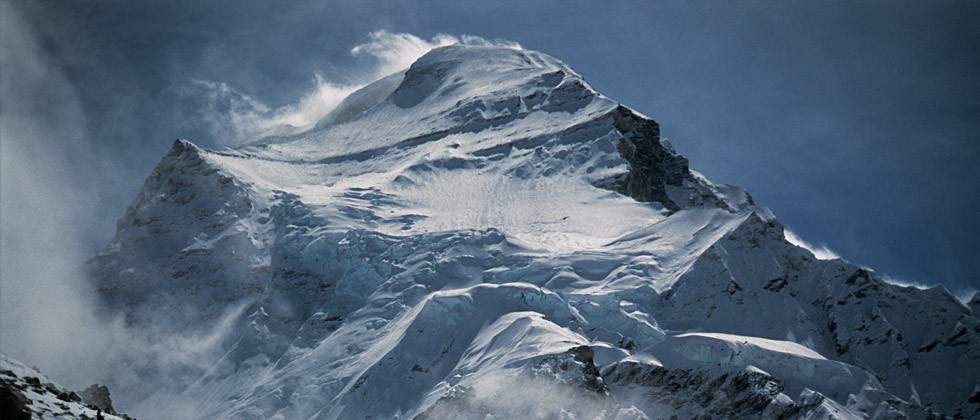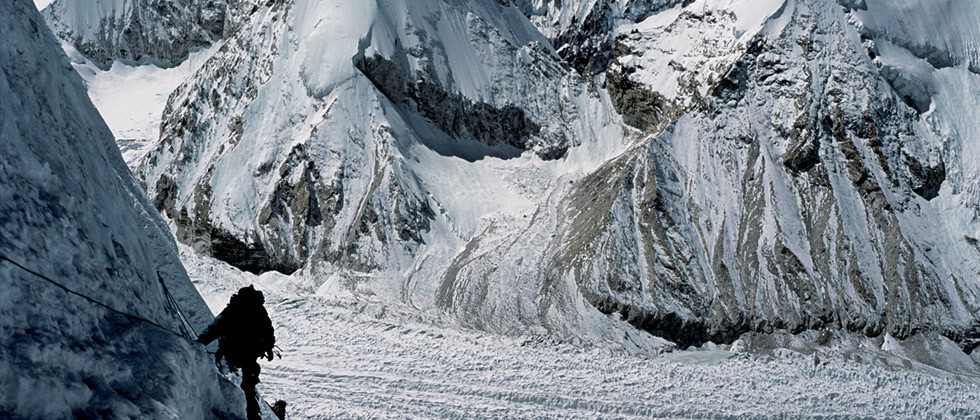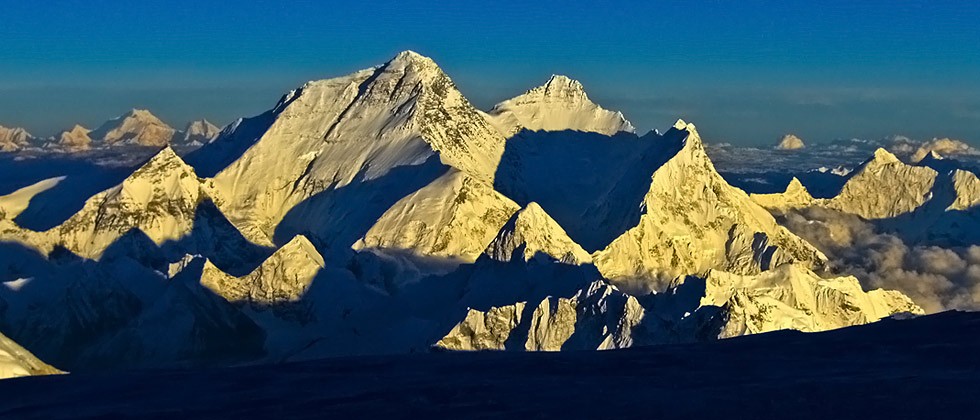Cho Oyu
8201m
- Himalayas, Tibet/Nepal
- Summit: October 2nd, 2006
- Second Romanian Ascent, no supplementary oxygen used, no Sherpa support.



Yaks are nasty animals. And so the yak herders. Sometimes to get with all your gear to the base of a climb can be a real challenge by itself...We got from BC into ABC in two days with a middle camp in between at 5400m.
It was still in the very morning of september 8th when our yak herders were starting a riot. They didn't want to carry our gear anylonger as they were saying the luggage is not the same as the day before and they were claiming more money for doing it. Of course, more amounts of gear catapulted in the middle of nowhere could just magically appear overnight only in some of their heads full of pot...it has been as in a psycho bad movie with us having our tent just near some tibetans smoking marihuana almost all night and myself couldn't get a decent sleep because of that...
Finally after being told they'll get no money if not resume the load carrying they made a "lottery " with small pieces of paper written in tibetan and "luck" decided whoever will take our four barrels:)) The way till ABC was over heavily glaciated terrain and the yaks discarded the loads several times on the way.
Moonson is not over yet so we had snow ever since our arrival in ABC three days ago. Our tents are merely small yellow dots lost in the immensity of the Gyabrag Glacier.
Just in front of us, Cho oyu rises on the main range of the himalayas to the east of the deeply cut pass nangpa la-5716m and 30km west of everest.
In the XVI century the whole tribe of the sherpas moved from eastern tibet through nangpa la, to the valleys of the southern side of the himalayas. Since then every year numerous caravans cross this pass, sometimes even in winter.
...back to our mountain, the massif is made up mainly of crystalline schists with numerous, sometimes thick, intrusions of pegmatite rocks. The summit dome, more exactly the very summit, is built of limestome rocks.
Regarding the name, Cho Oyu-"The Turquoise Godess", today it finally become clear to me why turquoise: in the morning light the ice irisations on the mountain are having the turquoise colour, giving the climber a surreal sight.
The mountain has been climbed for the first time by an austrian expedition led by herbert tichy back in 1954. It was an amazing feat for that time since the expedition wasn't employing the military expedition style of the epoque but a lightweight approach and very few climbers in the party.
For our climb, we will approximately follow their initial route, on what it is called now the northwest ridge route. In the next weeks, we will set up three high altitude camps on the mountain at approximately 6400, 7200 and 7600 meters, depending on the snow's condition...meanwhile, in the next three weeks we will complete our acclimatisation process and prepare the route for the final push from camp 3 to the summit.
But what is all that fuss about acclimatisation, high camps etc. and why one cannot just simply climb to the top of a high mountain? The human body functions at its best at sea level (0 meters) when the atmospheric pressure is measured at 1 atmosphere. This is because the hemoglobin (the red pigment in red blood cells) is saturated with oxygen (nearly 100 %) at that air pressure. Oxygen is required for every bodily process.
As humans go higher, the air pressure drops and so does the amount of available oxygen. At 5,000 m, the altitude of cho oyu base camp, the amount of oxygen is only half that of sea level's availability. At 8201m, the summit of cho oyu, only a little more than one third is available. When the amount of oxygen pressure drops, the human body tries to compensate by a process known as altitude acclimatization. Additional red blood cells are manufactured, the heart beats faster, non-essential body functions are temporarily shut down, and one breathes more deeply and more frequently. However, acclimatization cannot take place immediately - in fact, it takes place over a period of days or even weeks. Failure to acclimatize may result in altitude sickness, including pulmonary edema or cerebral edema.
At extreme altitudes (above 7,500 m), breathing bottled oxygen becomes almost mandatory for 99% of climbers. This is because at that height, available oxygen becomes so low that one can hardly function without supplementary oxygen. Sleeping becomes very difficult, digesting food is impossible (the body shuts the digestive system down), and hosts of other problems manifest without additional oxygen.
Finally, at the "death zone," 8,000 m and higher, no human body can acclimatize. Staying longer than necessary will result in deterioration of body functions, loss of consciousness, and, ultimately, death.
Altitude acclimatisation is the process of adjusting to decreasing oxygen levels at higher elevations, in order to avoid altitude sickness. Once above approximately 3,000 metres, most climbers follow the "golden rule" - climb high, sleep low. For high altitude climbers, a typical acclimatisation regime might be to stay a few days at a base camp, climb up to a higher camp (slowly), then return to base camp. A subsequent climb to the higher camp would then include an overnight stay. This process is then repeated a few times, each time extending the time spent at higher altitudes to let the body "get used" to the oxygen level there, a process that involves the production of additional red blood cells. Once the climber has acclimatised to a given altitude, the process is repeated with camps placed at progressively higher elevations. The general rule of thumb is to not ascend more than 300 metres per day to sleep. That is, one can climb from 3,000 to 4,500 metres in one day, but one should then descend back to 3,300 metres to sleep. This process cannot safely be rushed, and this explains why climbers need to spend days (or even weeks at times) acclimatising before attempting to climb a high peak. What can happen to you if not acclimatised is called altitude sickness. Altitude sickness, also known as acute mountain sickness (AMS) is a pathological condition that is caused by acute exposure to high altitudes. It commonly occurs above 3,500 metres. The most serious symptoms of altitude sickness are due to edema (fluid accumulation in the tissues of the body). At very high altitude, humans can get either high altitude pulmonary edema (HAPE), or high altitude cerebral edema (HACE). These syndromes are potentially fatal.
...it has been many days since starting to write this dispatch and due some technical problems with the internet we couldn't send in time text and pictures; that's why those written above might appear a little bit out of the time frame...or it might just be the altitude and the lack of oxigen determining me to jump from one topic to the other:)))...whatever ...:)
Anyway...tomorrow September 14th we will spend our first night at Camp 1 at 6400m. The day before yestersay we pitched our tent there and descended back to the ABC for further acclimatisation. It was a looooong himalayan working day. Both Sergiu and myself felt very tired but in the same time felt very very motivated by our job. The way from ABC to C1 over the glacier is very long and strenuos and the final part is a real killer slope especially if you are still acclimatising. We'll try to resume asap our pictures updates since Tingri continuing to all the ones to C1.
...I must have my beauty sleep now :) since tomorrow it will be again a loooong endless day of getting to C1 with heavy loads to make everything set for further establishing C2 at about 7200m...(ALEX)
I started my acclimatisation tour shortly after the breakfast and got up to 5500m and I felt good and pumped up,and I have passed by a slovak mountanieer which apparently gave me the looks . Some people are just idiots ,he thinks I'm his obstacle or what! And after one hour later he came and answer me if I didn't saw his Nepali cap... And this after he hasn't talk with nobody from the two romanian expedition a basc country one and a danish expedition. How's that a little respect wouldn't hurt afterall. Jackass! 7,th Tomorrow we will head for the middle BC to ABC and closer to the Cho Oyu's sillouethe shade. For now all we had to to is be good boys and mind the acclimatisation.
There we go 9 am and we already packed the tents and shootin' for middle camp. That's 4 hours of walking with a 25 kg backpack and the camera hanging over my chest and a scorching sun, there I was stomping the rocky way to middle base camp. I was running for it coz Ram told me the tents r going to b there and wanted to sleep after those gruellin' 3.5 hours.After I got there with Catalin, the same slovak team was already there but they took a tractor to the middle camp and they were there just a half an hour earlyer than us , as soon as they saw us theyr faces went really Long ,if U knowmy But I was to find out that the tents are gonna' b 7 hours later.
I was sweet in off by that time coz i've eaten 4 noodles bowls and two of them spicy as hell and made me sweat my ass.
As I was tellin' u 7 hours later there we go first Yacks red eye effect at about 70m in the dark and my heart start beating a bit harder and my first reaction was to wack the yack hearder right between his eyes and ask him to drop down and give me 30 pushups. So after we recovered our gear we gladly started to pitch the sillyest new age tent ,but I ain't gonna say its name and go to sleep. But when I was about to close my eyes a strong smell of weed came into our tent and swiched my curiosity on. What it waas , the neibourghing tent was a tibetan family and they were going hard out on some old dryed buds off marijuana .well looks like we have to get wacked aswell ,honestly the smell was very intense.
The second day we took of to ABC but this time we left the yacks go first and after an hour we left aswell.
The first part of the way my backpack was about 25kg but after another 3 hrs on the way it just became 1 tone .
I took my own rithm and left Alex behind because he was stopping for pictures to often . The sun was burning through my lips and nose despite the fact I have used the sun screen and when the backpack was getting heavyer I stumbled over a fucked up waterstream just in off wide so I can't jump over with my light weight pack but my luck was there!
Two tibetans were comin' from the ABC Jeeesus!!!. When they saw my face and they offered to help weee I was bouncein' arround like crazy .
After they crossed me and my bagpack I just realised I got no cash to give them some cash,but than they asked me for some food and happylly I had my lunch. And I gave them my lunch... Happy that I didn't have to wet my toes I started to walk high towards the ABC, but allofasudden that funky ,anoing sensation that gives u headaches HUNGER.... And 2 to 3 hours of hiking with that pack... Awwwww whatta fucked up fellin' to have when u don't know how much you still have to walk.
When I got closer to ABC the weather turned funky too; they just keept comin'... Finally a hope off better I saw Zsolt sitting on a big stone and I asked him how much do we have till ABC and he answered with a half a mouth 30 min , and why half a mouth coz his pack was 5 kg heavier than mine and he started an hour before me. Finally we got to ABfkinC broke in half and on a shitty weather the tents were no way near pitched...(SERGIU)
